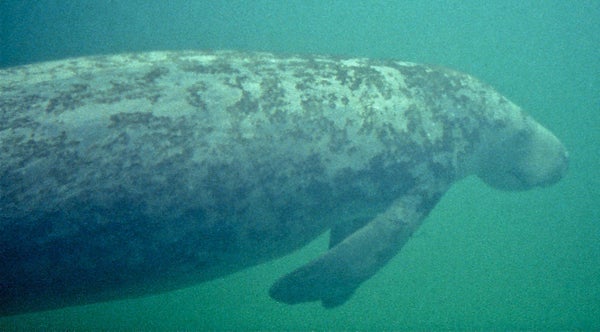This article was published in Scientific American’s former blog network and reflects the views of the author, not necessarily those of Scientific American
The U.S. Fish and Wildlife Service made headlines around the world earlier this month when it proposed that the Florida manatee (Trichechus manatus latirostris) and its relative the Antillean manatee (T. m. manatus) no longer be listed as “endangered.” Instead, the agency said, the famed sea cows should be considered merely “threatened,” a designation that means they’re no longer immediately threatened with extinction.
That may be true in Florida, but manatees face much greater threats elsewhere. In fact, some conservationists fear that this announcement could be the thing that pushes some populations of Antillean manatee—the subspecies that ranges through the Caribbean and down through about half of the east coast of South American—into extinction.
“The FWS is painting it as if things are good,” says Jamal Galvez, a research biologist with the Sea to Shore Alliance who has been working on manatee conservation in his native Belize for more than 15 years. “Their assessment doesn’t take into account what is happening down here in Belize.”
On supporting science journalism
If you're enjoying this article, consider supporting our award-winning journalism by subscribing. By purchasing a subscription you are helping to ensure the future of impactful stories about the discoveries and ideas shaping our world today.
What’s happening there isn’t very good. Just like in Florida, the manatees in Belize find their habitat shrinking due to coastal development, much of which supports the country’s vital tourism industry. Galvez says developers have dredged seagrass beds, torn out mangrove forests and built cruise ship ports in the critical habitats where manatees live.
More tourism also means more high-speed boats, and that means more injured and killed manatees. At least 40 manatees, the highest number to date, were killed in 2015 by boats or other human factors such as fishing nets. Three have already been killed this year, Galvez reports.
“The pressures that have been brought on this population have only been increasing through the years,” he says. “I can’t say that we have been able to stop anything that is having an impact on them.”
Belize actually has one of the largest populations of Antillean manatees. The country has approximately 1,000 of the animals living along its relatively small coastline, Galvez says, making it arguably the most important country for manatee conservation outside of the U.S.
Unfortunately, the recent FWS announcement made news in Belize, and Galvez says it has caused many people to believe that all manatee conservation is now a job well done and that the animals are no longer at risk. “People are calling me and saying ‘Jamal, you did it, you did it,’ and I’m not accepting that. I know that the population is not in a good place,” he says.
Galvez worries that the announcement will slow—or even reverse—the progress that he and other conservationists have had over the past decade. “We’ve worked so hard to get people to see that they are at risk and trying to convince people why they should change their behavior,” he says. All of that, he fears, is now up in the air.
“That perception that they are not endangered could very well cause them to go extinct,” he says.
Manatees are legally protected in Belize, but the country’s Wildlife Protection Act hasn’t been updated since 1981 and only goes so far. “It doesn’t do much to protect manatees by itself,” Galvez says.
What has apparently worked, however, is the U.S. Endangered Species Act. That law may not have had any direct influence in Belize, but Galvez says it does help small or developing nations like Belize to set the standards for both conservation and conversation. “Being on the Endangered Species Act was what really got people concerned about the manatee here in Belize.”
The next few years could be critical for Belize’s manatees. “We’re not even close to seeing this population as biologically stable,” Galvez says. “We don’t have information that they’re reproducing at the rates that we need.” Meanwhile, new ports continue to be built and the threats to manatees continue to grow.
Other dangers, such as global warming, potentially wait on the horizon. That’s why Galvez says tackling issues such as habitat loss, boat strikes, fishing nets and pollution is so important in Belize today. “We need to control the issues that we can control.”
